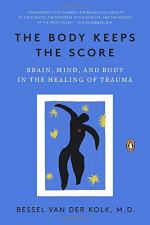
|
| Name: _________________________ | Period: ___________________ |
This test consists of 15 multiple choice questions and 5 short answer questions.
Multiple Choice Questions
1. How many fundamental avenues does Van der Kolk claim can "palliate or even reverse the damage" (13) caused by trauma?
(a) 3.
(b) 2.
(c) 5.
(d) 4.
2. What two activities were the only ones that could calm Tom when he returned from Vietnam?
(a) Binge drinking and riding his bicycle.
(b) Skydiving and smoking.
(c) Binge drinking and riding his motorcycle.
(d) Sleeping and eating.
3. What are the only people in Noam's drawing doing within his picture of the scene of 9/11?
(a) Flying.
(b) Running.
(c) Crying.
(d) Jumping.
4. What position did Van der Kolk hold when he first began to work at a mental health center?
(a) Night watchman.
(b) Recreation leader.
(c) Receptionist.
(d) Nurse.
5. When trauma survivors experience flashbacks, which part of their brains are the only areas to light up?
(a) The amygdala.
(b) The right side of the brain.
(c) The hippocampus.
(d) The left side of the brain.
6. On which symptom of Tom's did Van der Kolk focus his initial treatment?
(a) Facial tics.
(b) Insomnia.
(c) Nightmares.
(d) Incontinence.
7. Van der Kolk states that he wrote the book to serve "as both a guide" (14) and what other object?
(a) A hand.
(b) A
(c) A boost.
(d) An invitation.
8. What types of techniques became possible in the early 1990s and helped humans understand the way the brain processes information?
(a) Electrostatic.
(b) Sound therapy.
(c) Hydrotherapy.
(d) Brain-imaging.
9. In what year was the object issued that a group of veteran patients of Van der Kolk's gave him for Christmas one year?
(a) 1944.
(b) 1917.
(c) 1969.
(d) 1971.
10. What sort of object did a group of veterans to whom Van der Kolk provided care give him for Christmas one year?
(a) A medal.
(b) A scarf.
(c) A watch.
(d) A hat.
11. PTSD sufferers in the study explained by Van der Kolk nearly always went into what mode in response to being looked at?
(a) Survival.
(b) Attack.
(c) Self-pity.
(d) Aggression.
12. What was the name of Van der Kolk's "great teacher" who taught his students to be "skeptical about textbooks" (19)?
(a) Paul Harrington.
(b) Saul Zaentz.
(c) Elvin Semrad.
(d) Abram Kardiner.
13. What term does Van der Kolk apply to the "primitive" (88) part of the brain where PTSD sufferers experienced all activity when subjected to the gaze of others?
(a) The Periaqueductal Yellow.
(b) The Periaqueductal Gray.
(c) The Periaqueductal Black.
(d) The Periaqueductal Blue.
14. How old was Van der Kolk when he attended a summer camp and became interested in medicine?
(a) 9.
(b) 14.
(c) 16.
(d) 11.
15. What kind of role does Van der Kolk say Noam had been able to take in his own rescue, saving him from deeper trauma?
(a) Passive.
(b) Active.
(c) Thoughtful.
(d) Creative.
Short Answer Questions
1. In which part of the brain did PTSD sufferers show no activity when shown images of people looking at them with direct gazes?
2. Van der Kolk states that he grew up in which country during the postwar years?
3. In 1982, Van der Kolk accepted a position at a mental health center in what state?
4. Who coined the term "neuroception" (74) to describe the capacity to evaluate the safety within a particular environment?
5. In the dedication to the book, what object does Van der Kolk use to metaphorically characterize his patients?
|
This section contains 504 words (approx. 2 pages at 300 words per page) |

|




